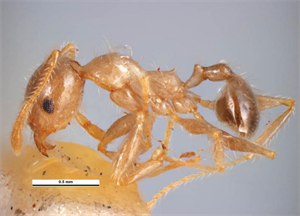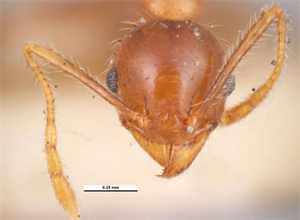- Worldwide distribution. Common in Pacific island countries. Among world's 100 worse invasive species.
- Nests under logs, stones, tree bark, leaf litter, and occasionally in houses. Prefers disturbed areas. Eat seeds, other insects, small lizards and birds, and honeydew. A scavenger. Once colonises established, biodiversity declines.
- Direct damage to agriculture seeds and plant parts; indirectly by defending aphids, mealybugs, scales and whiteflies from natural enemies.
- Queens mate inside colony. Workers are 'major' (big-headed soldiers) or 'minor' (much smaller workers) that rear the brood.
- Tramp ant; spread by 'budding' - queens, workers and brood move to new sites. Spread with international trade.
- Biosecurity: requires risk assessments, regulations preventing introduction, protocols in case of breaches, and ability to make rapid response. Pacific Ant Prevention Plan available (IUCN/SSC Invasive Specialist Group).
- Cultural control: hot water at 47°C kills ants; over 49°C kills plants.
- Chemical control: use (i) stomach poisons (fipronil, Amdro®, borax), (ii) growth regulators (methoprene, pyriproxyfen), (iii) nerve poisons (bifenthrin, fipronil, imidacloprid). See (http://piat.org.nz/getting-rid-of-ants).






